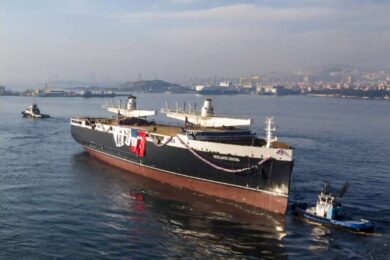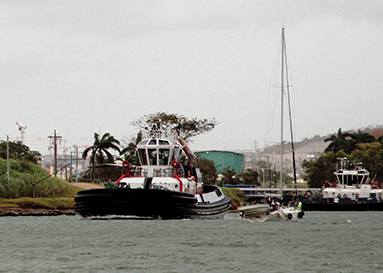Preparing your boat and crew for the Panama Canal Transit (published July 2015)
In last month’s issue we got your boat signed up for a Panama Canal Transit without paying an agent. Your boat now has its official Panama Canal Ship Identification number. You’ve signed your life away in official paperwork and have made your payment for the transit along with the buffer (security) deposit. In this month’s article we’ll cover the items you need to do to prepare the boat and crew before the transit and discuss the various ways you may transit the locks.
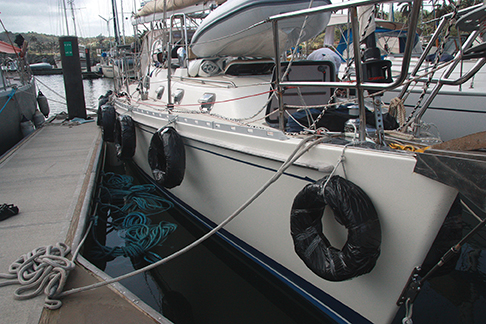
THE BOAT
To start with, you will need adequate fenders along with four 125 foot floating lines of an appropriate dimension. For most yacht transits this means 5/8-inch or 3/4-inch lines and tires covered with plastic trash bags. You can rent the lines and obtain the tires easily from local taxi drivers. On the Atlantic side many use Tito and on the Pacific, Roger (their contact info is available in Panama City Cruisers Guide—available free online from www.svsarana.com). Lines should cost about $65 for the set and wrapped tires about $2 each. The line charge includes picking up the lines at the end of your transit. You are responsible for disposing of the tires—if possible give them to another cruiser waiting to head through in the opposite direction.
According to the canal rules, the lines should be floating and have no splices or knots. This is to keep them out of the props and to avoid them getting hung-up on a fairlead while locking, which could be a dangerous situation, ripping out the fairlead and possibly injuring crew. In practice, some of the rental lines do have long splices in them and they seem to work fine. When you rent lines, they will generally be delivered to you one or two days before your scheduled transit. The lines may have been stored in carports or storage sheds, so I like to immerse them in seawater for a good dunking to convince any wayward cockroaches and bugs to swim off to other boats before bringing them aboard.
So how many tires should you get? That’s a personal choice. For me, at two dollars a pop, I go for a lot. I like to have them evenly spaced along the hull with the first one right near the bow and the last one right near the stern. These end fenders can save some embarrassment if you make a less than graceful exit while releasing a side-tie to a tug in the rush of big ship prop-wash induced current. On a recent transit we did on our 44 foot boat, we put on eight tires per side, in addition to our regular fenders and blowup fenders. You want your boat well dressed for the transit.
Speaking of well dressed, the Panama courtesy flag that you fly needs to be in good shape. Many cruisers have spent months in the Panama sun and tradewinds before transiting. Their flags can get pretty tattered. Panamanians are generally proud of their country and flag and some of the advisors simply will not take a vessel through with a tattered flag. On one transit I was line-handling on, we made it through the first three locks and spent the night on Lake Gatun. The next morning the advisor came out early and was sitting in the cockpit drinking coffee when he glanced up and saw the ragged courtesy flag. He was not happy about it, explaining that international tourists and Panamanian school children come down to the locks to view the boats locking up and down and learn about the country and it would be a disgrace to be displaying such a flag. After some negotiation, he allowed us to continue our transit as long as we pulled the tattered flag down. New courtesy flags are easily available at either end of the Canal for about $12.
Now that your stack of tires has been delivered, you have to tie them on to the boat. Some people feel it is necessary to use light twine so that if the tire gets hung up on another vessel it will break away before doing damage to the stanchions or toe-rail. Sometimes tires are delivered with this twine. If so, I use it. If not, I just cut up some old line and don’t worry about the breakaway aspect of it. Generally, I tie the tires and place the fenders fairly high. Leave the attachment lines long enough so that you can re-adjust their heights based on the vessels you may side-tie to during the locking.
You should look around your deck, lifelines, pushpit and pulpit. If practical, remove items that hang over the side, like barbeques and outboards. These can get in the way of the line handlers and might end up crashing against side-tied vessels. If you have a wind-generator, secure the blades so that no airborne lines can get entangled.
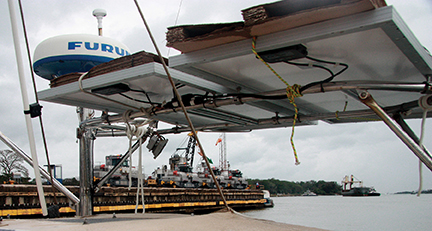
The canal specifically disclaims any liability for the monkey’s fists that are thrown to the boat by the line-handlers. This means you should cover your solar panels to protect them. Thick cardboard, seat cushions and foam all work.
THE CREW
Next on your list is preparation of the crew you’ll need to transit. You must have a Captain (the driver) plus four line handlers. They need to be old enough and physically fit to handle the job. I believe the canal says at least 16 years of age. Line handling is usually not that physically demanding as long as good technique is used. In a mixed gender crew, I have one male and one female on the bow so that some extra muscle is available if needed.
It is almost always reasonably easy to find other cruisers to line handle for you. They want to gain the experience so that their transit is less stressful. You are responsible for feeding the crew, providing sleeping quarters and getting them back to their start point afterwards. In addition, there are often backpackers who are traveling South America who are looking to experience a transit. Lastly, you can pay local line-handlers, sometimes referred to as ‘professional line-handlers’, to come along. The paid line-handlers range from very helpful to a major hindrance. One issue is that they often speak Spanish and feel they have extensive knowledge of what should be done. Picture a situation where you are rafted to another boat and approaching a wall-tied tug boat to tie up. This means you now have two advisors and two captains as well as the crew of the tug boat and maybe one of your professional line-handlers speaking Spanish to the tug crew with everyone thinking they are in charge and giving orders. It can be a recipe for confusion at best, disaster at worst. I much prefer to go through with cruisers who know something about handling a sailboat and the issues of living in close quarters.
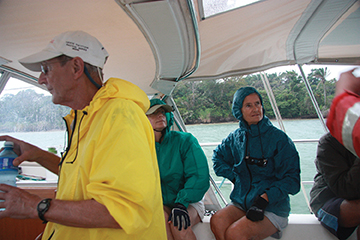
There is a tradition that the advisor is fed a good meal while on the transit. Forget about the stories of advisors calling out for extra meals to be delivered because they didn’t like the fare. Just create a menu, pre-cooked as much as possible, that will provide a nice lunch or dinner. Depending on the direction of transit and the timing, you may serve the advisor meals on both days of your transit or only one. You should purchase at least a flat of bottled water and a fair number of sodas. Depending on the time of year and conditions, it can get very hot and steamy inside the locks. I like to set up a small ice-chest on the deck filled with bottled water and sodas. This makes it easy for the line-handlers and advisor to grab drinks without going below or leaving their job for long. I also bring along enough soda (usually Coke) to offer drinks to the crews of any tugs we might side-tie to. Often you will side-tie to the same tug multiple times, so it’s good to be friendly with their crews.
You will need enough fuel on board for two days of motoring for probably a maximum of eight hours a day. Secure the fuel in advance, don’t plan to get it on your way out as you begin the transit. Panama is an advanced country, but it is still Central America where any given store could be closed for a whole host of reasons.
THE DAY OF THE TRANSIT
On the day of your scheduled transit you should be monitoring VHF Channel 12 listening for Cristobol Station on the Atlantic side or Flamenco Station on the Pacific side. At times they will contact you for changes of schedule or just to check that you are approaching the correct meeting spot for your advisor. I also call the canal scheduler earlier that day to check that no changes have occurred in the schedule. The most typical cause for a change is a lack of advisors for that day. I let all my line-handlers know that there could always be a shift in the schedule and ask them to do what they can to be flexible.
If you show up short of line-handlers, you will not be allowed to continue on. I know of one boat that broke a transmission cable on the way to pick up their advisor. They had one of the crew sit below and hand work the transmission for forward and reverse on orders from the helm. The advisor reluctantly let them do it this way, but they had to replace the crew that was below decks to get back up to the required four line-handlers. Fortunately, they were able to make a call on the radio and find another crew to go with them.
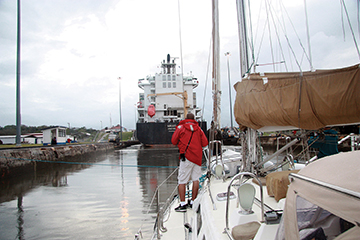
On the way out to meet the advisor, I have the crew prepare the long lines. There should be a three foot loop tied in the end of each line with a bowline, these loops will be dropped over the bollards on the sides of the locks. I make sure that the free end of the bowline is a little on the long side and then use a zip tie to secure it to the line. This ensures that the bowlines in these stiff lines do not come undone at inopportune times. I then have the crew set the loop to the outside of the lifelines/pushpit/pulpit and flake the rest of the line in large loops (say four feet long) on the deck making sure they will run free. This way each line-handler knows how the line is set up by her station.
I try to arrive about 30 minutes or so early at the meeting spot where you pick up the advisor. This is the anchorage know as ‘The Flats’ on the Atlantic side and just off Las Playitas anchorage near the edge of the canal on the Pacific side. Remember that whenever you have to cross into the canal itself (marked by buoys) you should call the appropriate signal station to ask permission. For example, when you are leaving Shelter Bay Marina to go to The Flats, after you exit Shelter Bay you should call Cristobol Station and inform them that you are a hand-line vessel leaving Shelter Bay heading to The Flats to meet your advisor. They will tell you of any traffic they have concerns about and usually ask you to call back when you arrive in The Flats. If you arrive an hour or so early, then you can anchor and await your advisor.
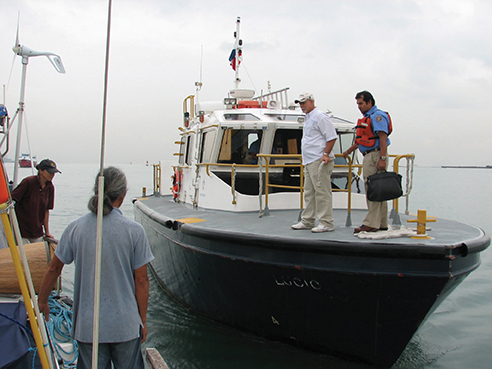
The advisor will be dropped off by a canal pilot boat. These are fairly large and will approach your midships with their bow. The skippers of these boats are very experienced and come close without touching. That said, I keep one large fender handy and assign someone to have it at the ready when the boat arrives. If you have side lifeline gates, have them open. The advisor will usually pass down a brief case or backpack and then hop aboard.
Introduce yourself and all the crew, making sure the advisor knows who’s the captain and who’s crew. If you’re bad at names like me, make sure you catch and remember the advisor’s name. ‘Hey you’ is not a good start when dealing with an emergency. I always like to find out what type of work the advisor does in his regular job with the canal, so I can pump them with questions when there’s time. Most are very open to explaining the working of the canal, the issues with construction of the new locks, and Panama in general.
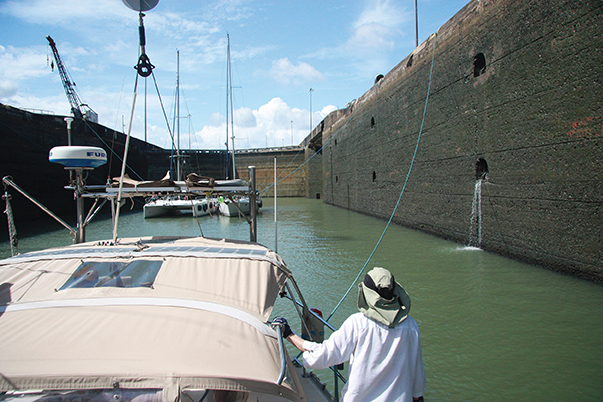
THE FIRST LOCK
Here we’ll run through a typical locking scenario starting at The Flats, on the Atlantic side. After we go through the typical approach, I’ll point out some of the different ways locking may end up being done.
After the advisor is on board, you will start traveling the short distance to the first set of locks (The Gatun Locks). This is a set of three locks that step you up from the Atlantic the 84 feet to the height of Lake Gatun, the artificial lake created by damming the Rio Chagres.
In the busy time of year, you will most likely go into the lock nested with other cruising boats, but I’ll describe going in as a single vessel to begin with. This way is the most work for your line-handlers. On the up-locks you will enter the lock behind the large ship using the lock. On the down locks you enter in front of the ship. You will enter the lock when the lock-master gives the signal to your advisor. There will generally be light current exiting the lock and at times some prop wash if the ship ahead is using his own props for propulsion. Normally they are moved forward by the locomotives, or ‘mules’, on the sides of each lock. You will hear the locomotives answering the requests of the pilot(s) on-board the ship with their sing-song bells.
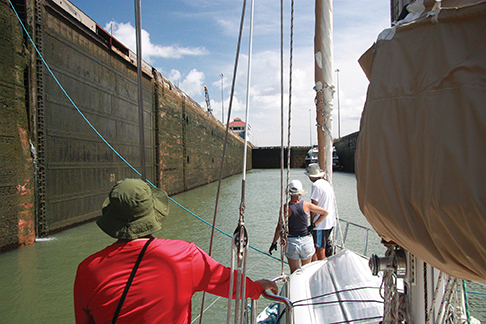
After you have passed the open lock doors, you will see the canal line handlers on the lock sides, usually two on each side. They will have a light line with a monkey’s fist on the end. The monkey’s fist will be thrown at your boat—one for the bow and one for the stern. Depending on the configuration of your vessel these may be thrown directly at the bow and then stern, or sometimes to mid-ships and you then need to take them outside the lifelines and back to your long lines. Your crew will then tie the monkey’s fist to the loop in their long line and hold the loop up so the shore-side line-handler can see it’s ready to go. The line may be taken in right away or the shore-side handlers may walk forward further and then take it in. The same process then occurs on the other side of your boat. Caution the crew to avoid being hit by a flying monkey’s fist. Also, when tying the monkey’s fist line to the loop, tie it so the knot is some distance away from the long line, making it easier for the shore-side line-handlers to untie and remove it from your line while it is still on the bollard. Otherwise they may ask your line-handler to slack the line at a time you may not want it to be slacked.
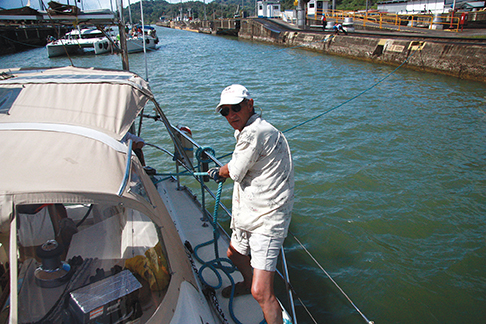
The adviser will tell the shore-side line-handlers which bollards they want the lines put on. The shore-side line-handlers will start taking up the lines as the onboard line-handlers feed them out, the big loops are then dropped over the bollards at the top of the lock. They then step back. It is now up to your onboard line-handlers to control things. Since you are no longer moving, you can’t do much driving of the boat. Now is the time where a pre-departure ‘prep’ lecture for the crew comes into play. First time line-handlers are always anxious about getting the monkey’s fist tied and controlling their line leading to a tendency to start yanking in their line the minute they see the loop go over the bollard. This is just likely to put you up sideways in the locks—an undesirable thing. Your line-handlers need to take time to look around at the boat and make sure that the others are also ready before they begin taking in and snugging their line. This should be a coordinated effort.
Communication is critical. Often times, the line-handlers on the bow are left out of the communication loop and start making decisions themselves. It’s important when plans change, as they often do at the last minute inside a lock, that you as the skipper make sure the bow crew know what is expected of them.
Once the boat is centered and the lock gates are closed, the water will begin to rise. The lock master determines how fast this occurs. The currents and swirling are clearly visible, but generally not that strong. The line-handlers will have the lines under the cleats and, if needed, snugged with a half twist. The lines to the lock sides are never cleated off while locking. Only a little slack will be needed to be taken in while the lock waters rise.
After the lock is full the forward doors will open and the locomotives will bring the big ship forward to the next lock. The shoreside line-handlers will then come back to the bollards, your advisor will indicate that the lines should be slackened and the loops will be dropped off the bollards with the monkey’s fist line still attached. This is the cue for your line-handlers to quickly bring the lines back to the boat till they get to the loop. If they all do this quickly, then you can get the boat moving and under control quickly. The shoreside line-handlers will walk along the walls with the monkey’s fist lines and climb the stairs to the upper next lock level. As they do this your line-handlers should hold the loops high in the air to help avoid getting a line snagged on the old concrete of the lock sides.
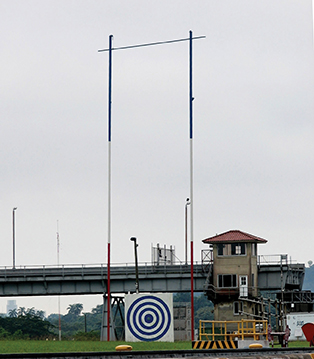
When you pass the lock gates and get to the next position you will stop the boat and the shoreside line-handlers will again take in your lines and place them on the bollards. You repeat the up-locking process again and move on to lock number three. Being the last of the three Gatun locks, it is handled slightly differently. Sometime after the loops are put on the bollards the shoreside line-handlers will remove the monkey’s fist lines. When the forward gates of the lock open the big ship in front will move forward via the locomotives and untie from them. It will then use its own power to propel itself forward, sometimes making for a pretty good wash passing back into the lock and at times bouncing off the back gates that are behind you. The pilots on the ships are aware that a small vessel is behind them in the lock and generally try to be careful, but be aware. At this point, the shoreside line-handlers will throw off the lines, without the monkey’s fist attached, and your line-handlers will bring it aboard.
MOORING FOR THE NIGHT
In most cases, you will then leave the locks and motor into Lake Gatun and on to the large mooring platforms. These are unlike any moorings I’ve used in other places. They are large discs with a bollard in the center that you can easily stand on and walk around. You bring your boat up to them so the mid-ships beam is touching, take the bow long line and pass it around the bollard and back to a center cleat. Do the same with the aft line. If another small boat arrives to share the mooring, they do the same thing on the other side of the mooring can, then you place a line from their bow to yours and their stern to yours. This stops the boats from hitting each other during the night.
Your advisor will then be picked up by a pilot boat to go home. Now is the time to open a beer and repeat as needed. Lake Gatun is reported to have a significant crocodile population and it is the drinking water reservoir for Panama City and you are not supposed to swim in the water—but I can never resist taking a quick dip after a hot day. You should also call the canal scheduling office to confirm your advisor pickup time for the next day. If it is to be later in the day, call again in the morning to reconfirm.
OTHER WAYS YOU MIGHT TRANSIT
Going center lock by yourself is the most work for your crew. In the busy yacht transit season you will most likely go through some or all the locks ‘nested’. Nested is the term used by the canal for being side-tied to another boat. Typically there will be three boats tied together with the larger, or perhaps the catamaran, in the center. If the boats are all close in size, this is an easy way to transit. Only the two outside line-handlers have much work today. The boats are nested together, one at a time, before entering the locks and do not break the nest till the last lock of the adjacent locks is complete.
Good communication between the boats in a nest is helpful. The outside bow and outside stern line-handlers should introduce themselves before entering the locks, to make it easier to communicate. Normally the center boat advisor is in charge and he will tell the outside vessel captains when to put on power in forward or reverse.
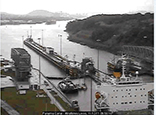
Quite often there will be another vessel, such as a canal tug being moved somewhere, that needs to lock through and this is another way you may transit. In this case, the tug will tie to the lock wall and then you will tie to the side of the tug. Remember that in the uplocks the current is generally running bow to stern while on the downlocks it is stern to bow. Make sure your line-handlers follow your or your advisor’s instructions about the order in which the lines are attached to the tug—and to politely disregard what the tug crew may say as they try to be overly helpful. The tugs are fairly round and can be tied to most anywhere along their length. Small cruise ships and work boats also transit the locks with a side-tie to the wall. In a fashion similar to tying to a tug you might also be told to tie to them. There may only be certain sections on the cruise ship where the crew can take your lines, so line up accordingly. Also, some of the work boats have outflowing water and exhaust pipes on their sides that are higher than your deck. You need to line up so these are not flooding your cockpit.
When you are done locking while side-tied to a tug, you will normally breakaway from them between each lock. You will often be asked to untie and drop back to make room for them to move to the next chamber. I usually ask a line-handler to have a large fender ready on the opposite wall side of the boat, just in case the prop wash and current combined with trying to move aft from the tug ends up putting us too close to the far wall.
The third way you might go through the locks is tied to the side wall. Most of the write-ups that I’ve seen say that sailboats do not tie directly to the wall. I assumed this was a rule and smart. But after watching some of the sportfishing boats go through this way and then taking a 45 foot sailboat through at night where there were not enough shoreside line-handlers to deal with center locking, I have found this to be a pretty decent way to go. Your boat will attach two lines via the monkey’s fists just as if going through center locked, except that you are nearer the wall when you get them so it is easier. Then you bring the boat to about five or six feet off the wall and an onboard line-handler will use a boat hook at midships to lightly hold the boat off the wall while the others tend to the bow and stern lines.
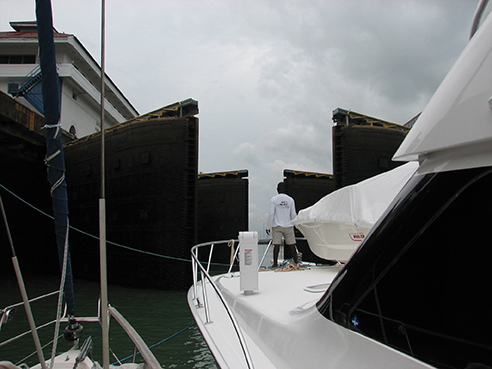
THE OTHER OCEAN
Once you and your crew have successfully negotiated your first set of locks, you will feel confident that you will be ready for the next set. When thinking about the time it will take to transit, remember that small boat canal transits are scheduled around the money-making freighter transits and those schedules can change daily. Generally, it will take two days to complete your transit. However, on the smallest boat I have taken through, a 35 footer, we did the transit all in one day, south (Pacific) to north(Atlantic). On another transit, this one north to south, we left the Gatun locks just after dark on our way to the overnight mooring when the advisor got a call and was told we were going overnight all the way through. We arrived at the Pacific side anchorage at about 2 a.m. The point is that each transit is different, but all are exciting and mostly fun. For some, it’s a new ocean to explore, for others it’s a leg in the trip back home, or perhaps for others it’s just another successful transit as crew. Meeting the challenges of negotiating the locks, the history of the canal, apparent in the 100 year old lock gates, and the landscape the canal cuts through, full of parrots and howler monkeys, all make each transit unforgettable.
Paul Lever and Chris Hunter have been cruising full-time for the past four years. They’ve ranged from Seattle to Mexico, and Panama to Cape Bretton and Nova Scotia. Their Outbound 44, Georgia, is currently in French Polynesia after another successful Canal transit and a visit to the Galapagos. Follow their adventures at svjeorgia.blogspot.com.

